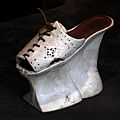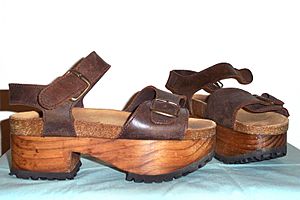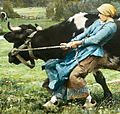Clog facts for kids
Clogs are a special kind of footwear that are made partly or completely from wood. People have worn them for a very long time in many parts of the world. While they might look different depending on the culture, their basic design often stayed the same for hundreds of years!
Even today, traditional clogs are used as protective shoes by people working in agriculture (farming) and in some factories or mines. Sometimes, people think of clogs as old-fashioned shoes for farmers or workers. But guess what? Some types, like Swedish träskor or Japanese geta, are actually considered cool fashion items now!
Clogs are also super important in different styles of dance. The cool sound they make when they hit the floor is a big part of the dance! Clog dancing is actually one of the main roots of tap dancing. However, tap shoes have special metal pieces that click together, making a different sound than clogs.
Contents
Different Kinds of Clogs
The word "clog" can mean a "thick piece of wood." When we talk about shoes, it means a "shoe with a thick wooden sole" or a "wooden-soled overshoe."
A traditional clog maker named Trefor Owen said there are three main types of clogs:
- Clogs with a wooden upper: These are made by carving out a single piece of solid wood to create both the top part of the shoe and the bottom. There are two main kinds:
- Whole foot clogs: The wooden top covers almost your entire foot, up to your ankle. A good example is the Dutch klomp. These are also called "wooden shoes." They can protect your feet so well that they act like safety shoes without needing extra strong parts.
- Half-open clogs: The wooden top only covers your toes or a little bit more. Belgian sabots are an example. They look a bit like a court shoe (a low-cut shoe). Half-open clogs might have extra fabric or leather straps to hold them on.
- Clogs with a wooden sole: These only use wood for the bottom part of the shoe. The top part can be made of different materials:
- Full tops made of leather: Like English clogs. For extra safety, they might have steel toe caps or steel pieces inside the soles.
- Open sandal style: For example, Japanese geta.
- Toe peg styles: Like Indian paduka, which have a small peg between your toes.
- Overshoes: These are wooden soles with straps, designed to be worn over your regular shoes for protection. They are often called pattens. Patten-style clogs aren't used much anymore, but modern galoshes (rubber overshoes) are similar and common worldwide.
These types can sometimes mix! Some overshoes look a lot like whole foot clogs, like Spanish albarca. And some wooden-soled clogs lift and protect clothing, just like overshoes, such as Japanese geta.
How you wear clogs depends on their top part. Whole foot clogs need to fit snugly, and you might curl your toes to keep them on. Wooden-soled clogs, however, are fastened with laces or buckles, so your toes can relax like in regular shoes. Half-open clogs might be held on like whole foot clogs, or they might have an extra strap over the top of your foot. Some sandal types, especially toe-peg styles, are worn more like "flip-flops," relying on the grip between your big toe and the next one.
How Clogs Move with Your Foot
Since clogs are mostly made of wood, they can't bend under the ball of your foot like softer shoes do. To help your foot roll forward when you walk, most clogs have the front part of the toe curved upwards. This is called the "cast."
Some clogs have special "feet" on the bottom, like Spanish albarca. The clog then pivots around the front edge of these "feet." Some Japanese and Indian clogs have "teeth" or very tall pegs attached to their soles. The clog can rotate around the front edge of the front "tooth" as you step forward.
In the Middle Ages, some pattens were made in two pieces, with a leather strip connecting them like a hinge. This allowed the shoe above to bend. Dutch Klompen might have a bit of extra space around the foot, which lets your foot bend and your heel lift a little inside or out of the clog. Thick, stretchy wool socks can also help with the fit.
History of Clogs
It's a bit tricky to know exactly when and how much wooden footwear was used in ancient times. This is because old records aren't always clear, and wood doesn't last forever. Plus, old clogs were often burned for firewood!
Some ancient Greeks seemed to wear kroúpezai, which were made of wood. The Romans called these sculponeae. Both the Greeks and Romans also made sandals by attaching leather straps to wooden soles in different ways.
In ancient China, people wore wooden jī as far back as the Han dynasty. One type was even decorated with colorful ribbons and designs for women to wear on their wedding days. Later, during the Jin dynasty, a different style was carved from a single piece of wood. After the Tang dynasty, people in southern China wore "boot clogs" (xuējī).
The oldest wooden shoes found in Europe were discovered in Amsterdam and Rotterdam in the Netherlands. These clogs are from around 1230 and 1280, and they look very similar to the wooden shoes still worn there today! Around this time, wooden pattens were used as overshoes. They helped protect people's socks and indoor shoes when walking outside, especially in bad weather. Some shoes then started to include the wooden platform right into their soles, like the Venetian chopines.
How Clogs Are Made
For a long time, wooden footwear was made by hand. This meant that the shape and how they were made varied a lot from one local area to another. In the early 1900s, machines started making wooden shoes.
After WW2, wooden shoes became less common. More fashionable shoes made of leather or synthetic materials took their place. Today, only the "Swedish clogs" (which have a wooden bottom and a leather top) are still seen as a trendy fashion item, often as high-heeled boots for women.
However, traditional wooden footwear is still popular in some parts of Europe and for certain jobs because they are very practical. Some old local styles have been replaced by standard national designs.
Gallery
Here are some typical clogs from different countries. Like many traditional items, where they are made and used often crosses modern country borders. So, you might find two or more different types in one country, or the same type in neighboring countries. For example, clogs from Denmark, Germany, the Netherlands, Belgium, and Northwest France look quite similar.
Traditional European Clogs
-
Belgian sabot from Belgium
-
Træsko from Denmark
-
Sabot from France
-
Holzschuh from Germany
-
Clogs from the North Sea coasts in surf; they are waterproof.
-
Zoccolo from Italy
-
Klumpės from Lithuania
-
Klomp from the Netherlands
-
Tamanco from Portugal
-
Cantabrian albarcas from Spain
-
Träskor from Sweden
-
Zoggeli from Switzerland
-
English clog from the United Kingdom
-
Galician zocas
Traditional Asian Clogs
-
Tai-Ping boots from China
-
Paduka from India
-
Bakiak from Indonesia
-
Okobo from Japan
-
Namaksin from Korea
-
Terompah from Malaysia
-
Bakya from the Philippines
-
Nalin from Turkey
Fashion Clogs
In the 1970s and 1980s, Swedish clogs became very popular fashion items for both guys and girls. People often wore them without socks, and they were seen as a cool, modern choice for men.
In the 1980s and 1990s, clogs based on Swedish styles came back into fashion for women. These were often platform clogs or sandals, with a very thick sole that could be 6 or even 8 inches high! This big middle layer was often made of solid cork, or sometimes plastic covered to look like cork. The bottom sole was usually light, sandy-colored rubber.
In 2007, Dutch designers Viktor & Rolf showed off high-heeled Dutch clogs on the fashion runway for their winter collection. Then, in 2010, Swedish clogs for women became popular again in Chanel's and Louis Vuitton's Spring / Summer 2010 collections.
Museums to Visit
- Bata Shoe Museum, Canada
- International Wooden Shoe Museum Eelde, Netherlands
- Bai Mi Wooden Clog Village, Taiwan
- Clitheroe Castle Museum, Lancashire, UK
Images for kids
-
Tengu geta have only one tooth.
-
In this 1883 painting by Fritz von Uhde, painted in the Dutch town of Zandvoort, clogs are shown to be the 19th century townspeople's normal footwear.
See also
 In Spanish: Zueco para niños
In Spanish: Zueco para niños






































